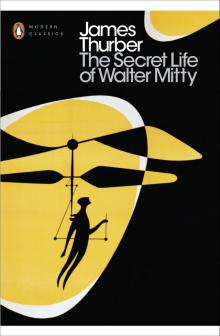- Home
- James Thurber
Thurber: Writings & Drawings Page 2
Thurber: Writings & Drawings Read online
Page 2
Fig. 3. Sex Substitutes (Übertragung Period): Craps.
The den was the beginning of male sublimation in this country, but the fruits of that sublimation were slow in ripening. At the start, in fact, they were in a state of absolute suspension. Man began to preoccupy himself with anything, no matter how trivial, which might help him to “forget,” as the lay expression has it. He thought up childish diversions, at which one person can amuse himself, and to justify his absorption in these futile pastimes he exaggerated their importance, as we shall see. These diversions included the diabolo, the jig-saw puzzle, linked nails and linked keys, which men took apart and put back together again, and most important of all, pigs-in-clover.
During this period almost no achievements of value, in art, science, or engineering, were forthcoming in the nation. Art, indeed, consisted chiefly of putting strange devices on boxes with the aid of a wood-burning set. The commonest device was the swastika, whose curiously distorted conformation bears no discernible relationship to any known phallic symbolism. Those years were blank, idle, lost years. Outside affairs of all kinds were neglected. Men retired to their dens and were not seen for days. The panic of 1907 was a direct result. It might be interesting to examine into a typical case history of the period.
Fig. 4. Sex Substitutes (Übertragung Period): Six-day Bicycle Racing.
CASE HISTORY
George Smith, aged 32, real estate operator. Unmarried, lived with mother. No precocious mother fixation. Had freed his libido without difficulty from familial objects, and was eager to marry. Had formed an attachment in 1899, at the age of 29, with a young virgin. Her Protective Reactions had been immediate and lasted over a period of three years, during which he had never even held her hand. Defense Devices: usually euchre (four-handed), or pedro. Definite and frequent fudge-making subterfuge. Post Office and Pillow, both with low degree of success.
Smith’s separation between the physical and the psychic occurred in 1902, the direct stimuli presenting themselves on June 6th of that year, examination (by Dr. Matthiessen) showed. On that day Smith ran, frightened, from a barbershop in Indianapolis, where he lived. Inside the shop, on the floor, a middle-aged man named Herschel Queeper had thrown a fit. Queeper had been trying for two days to get three little balls, under a glass in a tiny round box, to roll into an opening made for them (common pigs-in-clover puzzle). But no sooner would he get the third one in than one, or perhaps both, of the others would roll out. Mrs. Queeper was beginning to wonder where he was.
UNCONSCIOUS DRAWING: PLATE I.
Unconscious drawings, as they are called in psychoanalytical terminology, are made by people when their minds are a blank. This drawing was made by Floyd Neumann, of South Norwalk. It represents the Male Ego being importuned by, but refusing to yield to, Connecticut Beautiful.
Smith withdrew to his den and pondered and fiddled around and made Unconscious Drawings (Cf. Plates I, II, III and IV). He turned his attention from the object of his amorous affections to a consideration of the problems of pigs-in-clover. The usual Justification of Occupation occurred. It took the form of exaggerating the importance of finding out whether the puzzle could possibly be solved, and of working out a methodology of solving it more readily, if it could be solved at all. The case procured one of the little boxes and began to roll the balls toward the opening. At first he set about it quite calmly. There were no immediate signs of mental deterioration, either malignant or benign. But although the case got all the balls into the opening, thus proving that it could be done, he never got them all in at the same time. In the second month he threw a brief fit. This, today, would ordinarily prove the first step toward a complete physico-psychic breakdown, but in those days neuroses were staved off longer, owing to the general ignorance of psychology, and Smith not only calmly examined the effect of the fit upon himself, without calling in any scientists, but determined to go on and examine the effect of fits upon others. He decided, however, that it would be difficult to examine the effects of puzzle-fits upon men, because men brooked no examination when they were intent upon puzzles, and so he hit on the idea of having his dog, an animal named Dewey, play with the little round box until it threw a fit. But when he called in his dog he found, after several experiments, that the dog could not hold the box in either its right or left paw.* Furthermore, the animal was profoundly incurious about the puzzle.†
“Furthermore, the animal was profoundly incurious about the puzzle.”
Undismayed, Smith decided that somewhere in Indianapolis there must be a dog adroit enough to handle the box and sagacious enough to grasp the idea behind it, and with a view to finding such an animal, he determined to get all the dogs in town, and all the pigs-in-clover puzzles in town, into one room and see what would happen. (Apotheosis Complex, with Plurality Fallacy.)
UNCONSCIOUS DRAWING: PLATE II.
This was drawn by Peter Zinsner, 564 DeKalb Avenue, Brooklyn, without knowing it. We here see Sublimation in conflict with the Libido. Peter has reached a point in life where women seem so divine he doesn’t dare call them up on the phone. Yet they still call him.
UNCONSCIOUS DRAWING: PLATE III.
This is the work of Grace McFadden, aged 11, of Bucyrus, Ohio (R.F.D. #3, Bucyrus 6021, Ring 3), and was drawn on the day that Principal K. L. Mooney, of the Paulding County Concentration Grade Schools, was married. Here the Pleasure-Principle and the Wish Motive are both overshadowed by the Bridegroom Fallacy.
Smith was able, however, to round up only about 85 per cent of the dogs of the city, because there were many who were too busy to get away at the time. Even so, 85 per cent of the dogs in Indianapolis was more than had ever been got together in one room before. The case attempted to explain the problem to the dogs in short, one-syllable talks, but the bedlam was too loud and too prolonged for him to make himself heard. Fifty or more St. Bernards and a few dozen Chesapeake spaniels listened, half-heartedly, but the others made holiday. Furthermore, eighty-four bulldogs would not permit themselves to be muzzled, and this added to Smith’s difficulties. Thus, on the fifth day of the singular experiment, Smith, hearing a remarkable hullaballoo belowstairs (he worked in the attic), descended to the parlor, where he discovered the bulldogs engaged in a sort of tug-of-war, using a body Brussels carpet as a rope. (The case’s mother had several days before retreated to French Lick, in a rundown condition.)
This drawing was made from an old 1901 lantern slide often used by Dr. Karl Zaner in his illustrated lecture, “What Can We Learn from Animals?” Dr. Zaner has always contended that we can learn nothing of importance from animals beyond a few pointers on the art of relaxation. “Their general activities are, as a rule, not only meaningless to man, but frequently to themselves as well. This particular cat, for example, probably had nothing special in mind at all.”
Smith grasped the carpet firmly, with some idea of wresting it away from the dogs, whereupon all of them save three began to pull against him.* The Exaggeration Complex under which the case was laboring gave him strength enough to meet with some small success in his first efforts to take the carpet away from the dogs. He pulled them as far as the bay window in the parlor, largely because they had not settled down seriously to winning. When they did, however, the total of three hundred and twenty-four solidly implanted feet and the virtually immeasurable tugging potentiality were too much for Smith. He was slowly pulled out into the hall, through the front door, and into the street. He stubbornly contested every inch of the way until a drug store, three blocks away, was reached. Here some one had the presence of mind to call out the fire department.
Dr. Matthiessen, who took the case at about this period in its development, attempted to reduce the Magnification of Objective, first by Analytic Reasoning, and then by cold applications. Neither was successful. Matthiessen could not divert the libido. Smith declined to resume his interest in the feminine object of his affections, and insisted that his experiment with puzzles was a glorious project for the benefit of mankind.
>
It was sheer accident that saved the patient—not Dr. Matthiessen. Smith finally refused Dr. Matthiessen admittance to his house, nor would he go to the doctor’s office, claiming that he did not believe in psychology, but one day he dropped one of the little pigs-in-clover puzzles and broke the glass in it. He then found that he did not have to roll the balls into the openings, but could push them in with his finger. He got a hammer and broke the glass in all the thousands of puzzles he had brought to his home for the dogs, and solved every one of the puzzles by pushing, not rolling. This instantly released him from his complex by the Gordian Knot principle of complex release. He thus gained the necessary confidence and sense of power to feel worthy of the woman with whom he was in love, and he finally married her. The marriage was of average success.
UNCONSCIOUS DRAWING: PLATE IV.
The mood captured in this drawing is a rare one indeed, and Dr. Karl Zaner considers the sketch the finest in his collection. Here the masculine sense of Ironic Detachment rises superior to the Love Urge and can take it or let it alone. The drawing was sent to Dr. Zaner by Mrs. Walter L. Mouse (née Kathleen Schaaf), recently divorced wife of the author of the drawing, Walter L. Mouse, of Columbus, Ohio.
Marriages, however, were frequently delayed much longer than in the case of George Smith, and it was not, indeed, until 1909 that the usual norm was restored. Meanwhile, in between the time of the first general separation of the physical and the psychic in this country, and the final culmination in marriages, a period of sublimation set in. This followed directly on the heels of the remarkable and lamentable era of preoccupation with trivial diversions and was characterized by an extravert interest in truly important projects and activities. The airplane was brought to a high stage of development, the telephone transmitter was perfected, tungsten replaced carbon as a filament for incandescent lamps, better books were written, art progressed, there was a cultural advance generally and the birth of a new Æsthetic, and people began to get at the real facts in the Thaw case. Nevertheless, Pedestalism has left its serious effects. It is doubtful if they will fully wear off for another fifty or seventy-five years.
The Lilies-and-Bluebird Delusion
THE YOUNG BRIDEGROOM who unexpectedly discovers that his wife has been brought up in extreme unawareness of the true facts of life and believes in some variant of the Birds and Flowers Delusion (that is, that birds and flowers have something to do with the emotional life of persons), is faced with a situation calling for the greatest tact and tenderness. It won’t do any good for him to get mad, or to indulge in self-pity, crying, “Oh, how sorry I am for me!” and only a coward would go directly into a psycho-neurosis without first trying to win his wife over to acceptance of things as they are.
I have in mind the case of a young lady whose silly mother had taught her to believe that she would have a little son, three years old, named Ronald, as soon as her husband brought a pair of bluebirds into a room filled with lilies-of-the-valley. The young woman (to say nothing of the young man) was thus made the victim of one of the extremest cases of Birds and Flowers Fixation which has ever come to my attention. I shall transcribe, from Dr. Tithridge’s notes, the first dialogue on the subject that took place between the young couple. This dialogue was carefully reconstructed by Tithridge from the account of the incident as given by the young husband, who sought his advice and counsel.
On the evening of the 25th of June, when the couple were married, the young husband entered their hotel suite to find it literally a garden of lilies-of-the-valley. He was profoundly touched, but baffled, and asked his wife who was dead.
“Where are the bluebirds?” she replied, coyly.
“What bluebirds?” he demanded.
“The bluebirds,” she said, blushing.
DR. WALTER TITHRIDGE
(after the etching by Veerbluergen)
Unfortunately, but not unnaturally, the bridegroom did not know what the bride was talking about. What was of the extremest importance to her, was to her husband merely an idle whim, a shadowy fancy. Obviously, the young couple should have talked such matters over long before, but they hadn’t, and there they were. He strove to change the subject, whistled, lighted cigarettes, for he was nervous enough the way it was, but she kept recurring to the bluebirds. His bewilderment became tinged with some alarm, for during their courtship he had put forth no great effort to examine into her mental capacity, and he was now assailed by the excusable suspicion that she was perhaps not exactly bright. He talked rapidly, apprehensively, of many things. Among the things he talked about were the St. Louis Cardinals (a baseball club). From there it was but an easy associative step for his wife to go back to the bluebirds again.
“Aren’t you going to get any bluebirds?” she persisted.
“I don’t know where the hell I’d get any bluebirds tonight,” he said, rather irritably, “me not being Bo-Peep.”
The nuclear complex was made right then and there. There was a long tense silence, after which the bride burst into bitter tears.
“Now, dear,” said her husband, more reasonably, “let’s try to get this thing straightened out. What are you talking about, anyway?”
“Sex—if you want to know!” she blurted out, and swooned.
Instead of getting her a glass of water, he excitedly phoned the room clerk, but became embarrassed once he had got him, and merely asked that a couple of blankets be sent up. It was, unfortunately, as I have said, June—and warmish. Thus when the wife revived sufficiently to become aware of her surroundings, the husband was standing above her holding a pair of blankets, and looking pale and warm.
“Mutual suspicions of mental inadequacy are common during the first year of any marriage.”
“What are those for?” she demanded, suspiciously, for the notion had now formed in her own mind (Dr. Tithridge feels, and I agree) that she very likely had married a dementia præcox case. These mutual suspicions of mental inadequacy are common during the first year of any marriage, but rarely are they aggravated by factors so clearly calculated to upset the mental equilibrium as bluebirds at midnight and blankets in June. This husband and wife were drifting farther and farther apart. The solution to their problem was becoming more and more remote, what with this setting up of involved artificial barriers, this almost fantastical beclouding of the issue. Dr. Tithridge tells me that he believes the young man’s reason would have been permanently dethroned had he (Dr. Tithridge) tweeted or chirped like a bird* on the occasion of the husband’s first visit to him.
When the wife beheld her husband standing there with the blankets, she demanded, again, “What are you doing with those blankets?”
“I get cold,” he mumbled, and he proceeded to put the blankets on the shelf of a closet which already held several extra pair. He was, furthermore, decidedly warm, and kept patting his brow with a handkerchief.
“Let’s go out and take a walk,” suggested his wife, apprehensively. To this her husband very readily agreed. They were getting afraid to stay in the same room with each other, than which there is no other condition in the world more certain to break up a marriage. Out in the street, among people, they both felt safer, and they wandered to a bench in a fairly crowded park, and sat down.
“Where did you get the idea that birds have anything to do with us?” demanded the bridegroom.
“My mumsy,”† she said.
“Well,” he said, “she deceived you.”
“About what?”
“About what you’re talking about.”
“Sex?” she asked.
“That isn’t sex, honey,” he told her. “Birds and flowers are simply . . . they do not . . . that is, we could live all our life without them.”
“I couldn’t,” she said, and, after a pause, “I always feared you didn’t want children.”
“I do want children. I want you. You want me. Everything is going to be all right.”
“How is it?” she demanded.
“In the first place,” he
began, pulling at his collar, “it’s this way. Now here’s the way it is. Now you take me . . . or take you, say. In the first place the girl, that is Woman . . . why, Woman* . . .” He lapsed into a profound silence.
“Well, go on,” she prompted.
“Well,” he said, “you know how women are, don’t you?”
“Yes,” she said, doubtfully.
“That’s fine,” he said, brightening. “Now women are that way, then——”
“What way?” she asked.
“Why, the way you are . . . from me . . . than I am, I mean.” He made a vague gesture.
“I don’t see what you mean,” she said. Her husband gave a light laugh.
“Hell’s bells, it’s simple enough,” he cried, suddenly, giving the light laugh again; “it’s certainly simple enough. Now, here. We’ll take Adam and Eve. There they were, all alone, see?”
“There were two bluebirds,” said his wife.
“Not till after the flood, there weren’t,” he corrected her. “Well, he found out that there were certain essential differences—what you might call on purpose. I mean there must have been some reason. You can count on it that things like that just don’t happen. Well, then, he simply figured it out—figured out the reason.”

 The 13 Clocks
The 13 Clocks The Wonderful O
The Wonderful O The Secret Life of Walter Mitty
The Secret Life of Walter Mitty Writings and Drawings
Writings and Drawings The Thurber Carnival
The Thurber Carnival Collected Fables
Collected Fables Thurber: Writings & Drawings
Thurber: Writings & Drawings